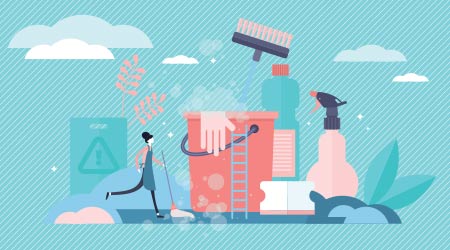
Since the pandemic, the demand for thorough cleanliness and sanitation has skyrocketed. From an optics standpoint, the appearance of clean has also been elevated in scrutiny — and floors are at the forefront.
Floors are the first thing occupants see when entering a building and they create an immediate impression. If the floor looks grimy, dull or downright dirty, customers may go someplace else for fear that the rest of the facility is unsanitary.
A good floor care program encompasses more than what most people think. It actually starts outside the building, says Phil Carrizales, director of the Hygiene and Facilities Solutions division at Acme Paper, Jessup, Maryland.
“Sweeping, matting, and pressure cleaning aid in keeping dirt and debris out, which helps lower the cost of interior maintenance,” says Carrizales.
He also suggests considering the following objectives for keeping floors looking their best:
First impressions — There’s only one chance at a first impression. Whether it’s at a grocery store, school building or a retail location, unsightly floors might be enough to turn people away. On the other hand, a well-maintained floor helps with employee satisfaction. When employees notice cleaning crews going the extra mile to elevate their work environment, it can elevate their productivity.
Safety — Clean floors are safer, while dirty floors can create slip, trip or fall hazards, resulting in large settlements.
Preserve the asset — When the floor lasts longer, facilities accumulate cost savings and fewer major disruptions associated with replacements.
Keith Schneringer, director of channel marketing and sustainability for Waxie Sanitary Supply, San Diego, adds in the health component.
“Health is the No. 1 consideration because dirt on floors can be carriers of microorganisms and responsible for indirect transfer — via shoes or an item picked up off the floor — of pathogens to people,” says Schneringer.
Mindful Of Microorganisms
While toilet seats often have a perception for dirtiness, researchers at the University of Arizona found that, in many cases, shoes actually carry more harmful pathogens. In fact, a study found nine different species of bacteria on shoe bottoms, some of which can cause stomach, eye and lung infections.
Different flooring types actually attract different bacteria and spread it in various ways. For example, hospital floors are often soiled with antibiotic-resistant bacteria within a short time of patient admission, according to a study published for the “Decennial 2020: The Sixth International Conference on Healthcare-Associated Infections.” In the study, VA Northeast Ohio Healthcare System researchers discovered that contamination coming from the floors was transferred to hospital socks, bedding and adjacent surfaces.
“With the overuse of quat-based disinfectants on floors, a biofilm can be produced, which allows microorganisms to thrive under the self-sacrificing top layer,” says Carrizales.
Combating bacteria-ridden floors should be a priority for janitorial teams and must be outlined in cleaning proposals. Once procedures are in place, experts agree that accurately tackling floors will require proper use of chemicals.
First and foremost, train frontline staff on proper chemicals, dilutions and mixing instructions. Improper mixing can expose workers and building occupants to hazardous fumes, says Linda Silverman, president of Maintex Facility Solutions, City of Industry, California.
Less hazardous to people, but still a detriment to floors is increased chemical use or over spraying. Potential damage depends on the chemicals being applied to the floor finish, says Gordy Gillette, director of marketing and sales for SupplyDen, Auburn Hills, Michigan.
He recommends using a neutral cleaner on floors with a finish. Those break down mild soils but don’t attack the surface of the finish. A general-purpose alkaline cleaner will break down the finish after prolonged use, leaving the floors looking cloudy and dull.
“Most disinfectants also attack the floor finish after time, even if a neutral disinfectant is used,” says Gillette. “Use a product with a shorter dwell time if the floor must be disinfected, which should minimize the dulling effect.”
He also stresses training on proper dilution. When neutral cleaners are mixed too strongly, the result is often a hazy surface.
“Many janitors think the more chemicals, the better, but that’s not the case,” says Silverman. “BSCs who struggle with frontline compliance in this area should opt for automated dilution systems.”
Maintex uses a measuring device that portions out the right amount of chemicals, which Silverman says is key to employee safety. Simplifying the process and numbering different containers depending on floor type eliminates the possibility of employees incorrectly using chemicals.
Certified Products Prevent Greenwashing

 The Down and Dirty on Cleaning in Virus Season
The Down and Dirty on Cleaning in Virus Season How Surfactant Use is Expanding in Commercial Cleaning
How Surfactant Use is Expanding in Commercial Cleaning